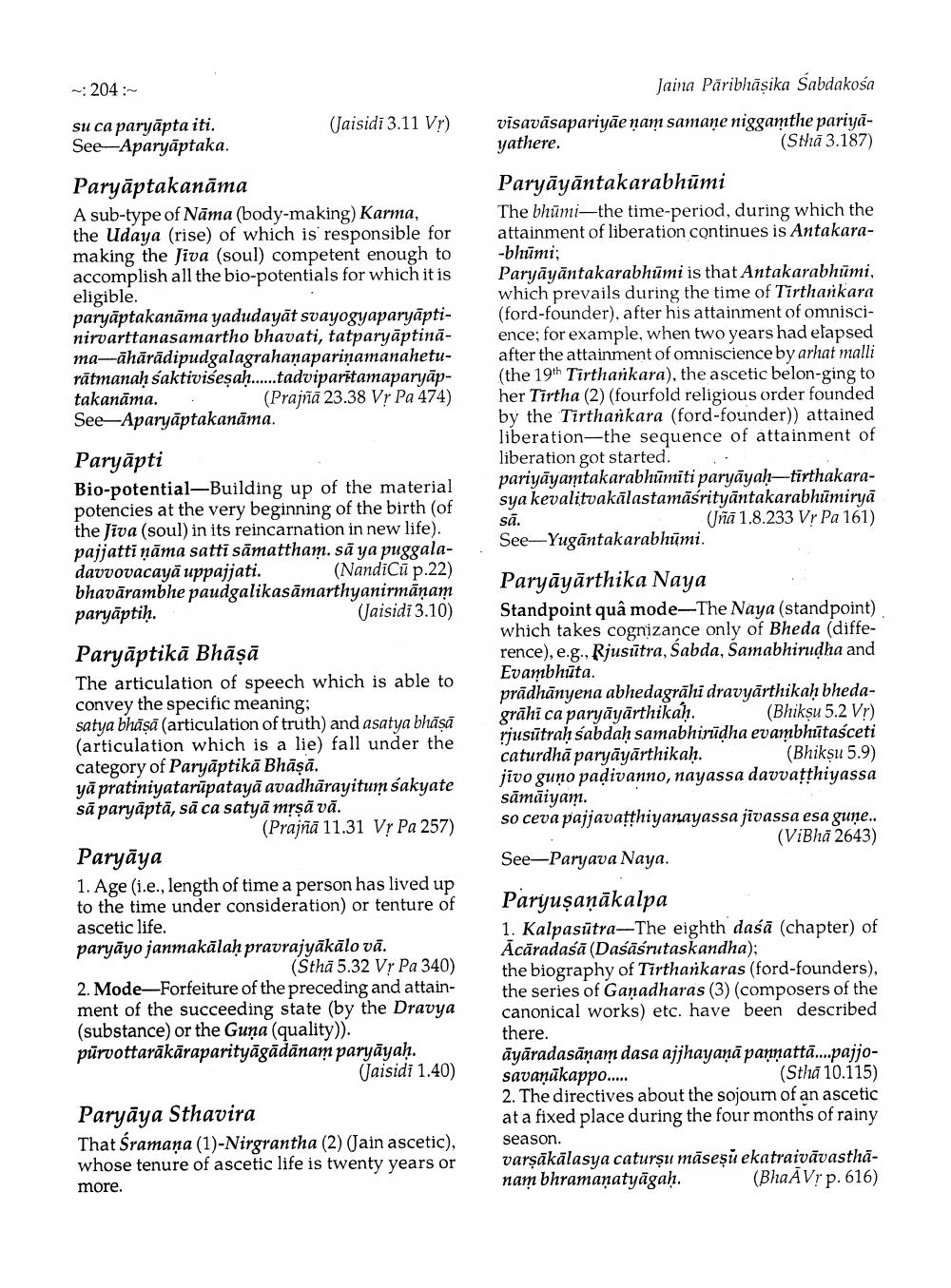________________
-: 204:
(Jaisidi 3.11 Vr)
su ca paryāpta iti. See-Aparyāptaka.
Jaina Päribhāșika Sabdakosa visavāsapariyāe nam samane niggamthe pariyayathere.
(Sthā 3.187)
Paryāptakanāma A sub-type of Nāma (body-making) Karma, the Udaya (rise) of which is responsible for making the Jiva (soul) competent enough to accomplish all the bio-potentials for which it is eligible. paryāptakanāma yadudayāt svayogyaparyāptinirvarttanasamartho bhavati, tatparyāptināma-āhārādipudgalagrahanapariņamanaheturātmanaḥ saktivisesah......tadviparītamaparyāptakanāma. . (Prajna 23.38 Vr Pa 474) See-Aparyāptakanāma.
Paryāyāntakarabhūmi The bhūmi—the time-period, during which the attainment of liberation continues is Antakara-bhūmi; Paryāyāntakarabhūmi is that Antakarabhumi, which prevails during the time of Tirtharkara (ford-founder), after his attainment of omniscience; for example, when two years had elapsed after the attainment of omniscience by arhat malli (the 19th Tirthankara), the ascetic belon-ging to her Tirtha (2) (fourfold religious order founded by the Tirtharkara (ford-founder)) attained liberation-the sequence of attainment of liberation got started. pariyāyamtakarabhūmiti paryāyaḥ-tirthakarasya kevalitvakālastamāsrityāntakarabhūmiryā sā.
(ña 1.8.233 Vr Pa 161) See-Yugāntakarabhūmi.
Paryāpti Bio-potential-Building up of the material potencies at the very beginning of the birth (of the liva (soul) in its reincarnation in new life). pajjatti ņāma satti sāmattham.sā ya puggala- davvovacayā uppajjati. (NandiCü p.22) bhavārambhe paudgalikasamarthyanirmāņam paryāptih.
(Jaisidi 3.10)
.
Paryāptikā Bhāṣā The articulation of speech which is able to convey the specific meaning: satya bhāsā (articulation of truth) and asatya bhāsā (articulation which is a lie) fall under the category of Paryāptikā Bhäşā. yā pratiniyatarūpatayā avadhārayitum sakyate sā paryāptā, sā ca satyā mặşā vā.
(Prajna 11.31 VỊ Pa 257) Paryāya 1. Age (i.e., length of time a person has lived up to the time under consideration) or tenture of ascetic life. paryāyo janmakālah pravrajyākālo vā.
(Sthā 5.32 Vr Pa 340) 2. Mode-Forfeiture of the preceding and attainment of the succeeding state (by the Dravya (substance) or the Guna (quality)). pūrvottarākāraparityāgādānam paryāyaḥ.
(Jaisidi 1.40)
Paryāyārthika Naya Standpoint quâ mode—The Naya (standpoint). which takes cognizance only of Bheda (difference), e.g., Rjusūtra, Sabda, Samabhirudha and Evambhūta. prādhānyena abhedagrāhi dravyārthikaḥ bhedagrāhi ca paryāyārthikah. (Bhiksu 5.2 Vr) rjusūtrah sabdaḥ samabhirudha evambhūtasceti caturdhā paryāyārthikah.
(Bhikṣu 5.9) jivo guņo padivanno, nayassa davvaţthiyassa sāmāiyam. so ceva pajjavatthiyanayassa jivassa esa gune..
(ViBhā 2643) See-Paryava Naya.
Paryusaņākalpa 1. Kalpasūtra—The eighth daśā (chapter) of Ācāradaśā (Daśāśrutaskandha); the biography of Tirtharkaras (ford-founders), the series of Ganadharas (3) (composers of the canonical works) etc. have been described there. āyāradasāṇam dasa ajjhayaņā pannattā....pajjosavaņākappo.....
(Sthā 10.115) 2. The directives about the sojourn of an ascetic at a fixed place during the four months of rainy season. varşākālasya caturşu māseșu ekatraivāvasthānam bhramanatyāgah. (BhaAV, p. 616)
Paryāya Sthavira That śramana (1)-Nirgrantha (2) (Jain ascetic), whose tenure of ascetic life is twenty years or more.




